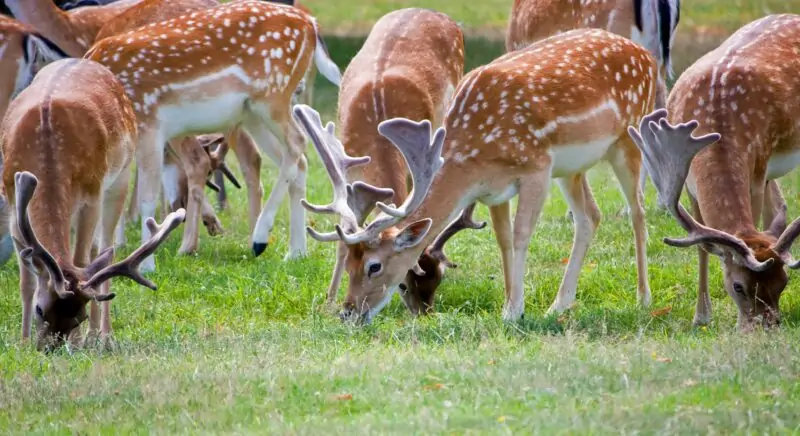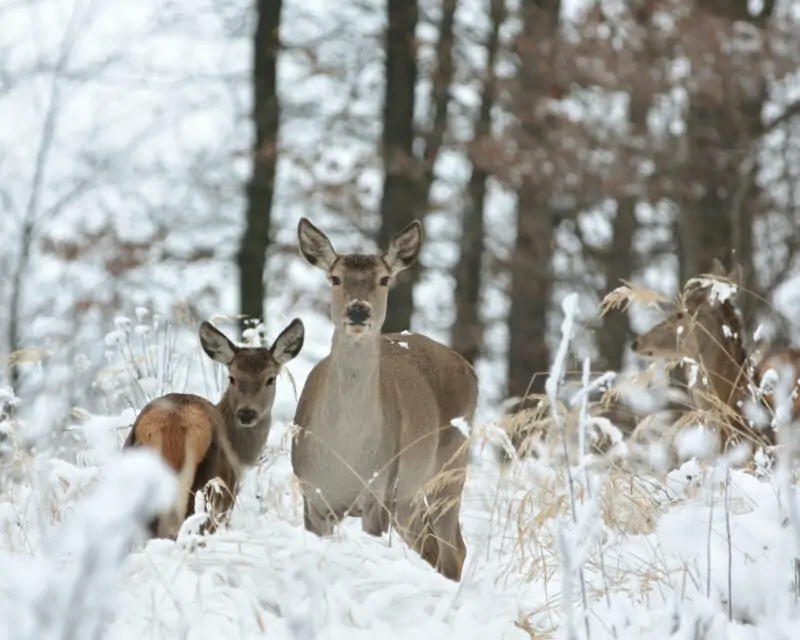What Do Deers Eat: A Comprehensive Guide to Deer Diet and Winter Food

Warning: Undefined property: stdClass::$error in /sites/makeoveridea.com/wp-content/themes/theissue/inc/misc.php on line 71
Hello there! Today’s topic will take us into the lush forests and serene meadows, as we delve into the culinary world of the graceful deer. Our primary focus is to answer the question, “what do deers eat?” If you’ve ever pondered about the dietary preferences of these magnificent creatures, this is your go-to guide. From an average nature enthusiast to a seasoned wildlife observer, this is a fascinating area to explore.
Understanding Deer Behavior
When we think of deer, particularly the famous white-tailed deer or ‘whitetails,’ we should first acknowledge that they are true herbivores. This means they feed on plant matter, and oh boy, they sure are picky about it. With their dainty narrow snout and long, nimble tongue, deer are masters of selecting the most nutritious and tasty bits from a plethora of plant species.
The whitetails are quite the adventurers, having made their home across the vast expanse of the American continent. Their habitat ranges from the snow-capped landscapes of northern Canada down to the tropical paradise of South America. This versatility is a testament to the adaptability of the deer and their remarkable ability to modify their diet according to their environment.
The Significance of Deer Diet
Understanding the dietary preferences of deer is not merely about listing their favorite snacks. It’s much more significant, as it directly impacts the health and survival of deer populations. A deer’s diet profoundly influences its growth, reproduction, and overall vitality. When food is plentiful, deer thrive and their numbers swell. Conversely, food scarcity can lead to poor health, lower birth rates, and can significantly reduce the deer population.
Deer Diet
An Overview of What Deer Eat
Now that we have set the stage let’s delve into the deer’s diet. So, what do deer eat? Deer are fond of a mixed menu. This includes but is not limited to, tender twigs, juicy buds of woody plants, lush broad-leaved plants known as forbs, and the occasional treat in the form of a juicy acorn or sweet berry.
During the winter months, when snow blankets the ground and food sources are hard to find, deer resort to eating leaf buds and evergreen leaves. It’s like their version of a winter comfort meal.
The Importance of Forage in a Deer’s Diet
Forage is a fancy term that includes all the grass, leaves, stems, and other parts of plants that animals eat. For deer, forage forms the bulk of their diet and is their primary food source. This includes a variety of grass, herbaceous plants, and green foliage and browse. Even when food is scarce, such as in the heart of winter, deer can still eat these items and extract essential nutrients to survive.
Nutritional Requirements and Feeding Habits of Deer
Deer are pretty big eaters. A healthy 150-pound deer can chomp down an impressive 12 pounds of food per day. Now, that’s a hearty appetite! Their feeding habits and dietary requirements vary greatly, depending on the season, the type of available vegetation, and the specific nutritional needs at different stages of their life cycle.
A deer’s digestive system, particularly their rumen, is specialized to break down complex plant materials. This allows them to extract nutrients from a wide array of food types, even those that other herbivores might find indigestible.
What Do Deer Eat?
Common Types of Foods Deer Like to Eat
Deer are not very adventurous when it comes to their diet. They have their favorites and stick to them. In the wild, deer have a strong preference for forbs, mast (this term includes yummy acorns and berries), and certain plants like young trees and woody browse. Even in the winter, when food supply can be limited, deer eat twigs and the buds of young trees. The fact that these are easily digestible and nutritious makes them a preferred food source during the cold months.
Forage: The Essential Component of a Deer’s Diet
Deer tend to focus their feeding on forbs, the lush, broad-leaved plants that provide the majority of their diet. But when these aren’t available, especially during winter in northern regions, they are quite capable of switching their diet. Deer eat browse, which includes the tender shoots, twigs, and leaves of trees or shrubs. In these times, deer’s salivary glands produce enzymes that help deactivate secondary plant compounds in these less preferred but still palatable food items.
Unusual Foods Deer May Eat
Deer are often seen as creatures of habit, sticking to the types of food they prefer. However, they are known to surprise us sometimes. Although deer are primarily herbivores, they have been known to eat some unusual food items when their normal diet is not readily available. Berries, acorns, and even a small amount of corn might be eaten by deer when necessary. But remember, they shouldn’t eat too much corn; it’s difficult for a deer to digest and can cause health issues.
White-tailed Deer
Where Do White-tailed Deer Live?
White-tailed deer live across a broad range of habitats, all the way from Canada to South America. The habitats of these deer can include forests, grasslands, and even suburban areas. They are highly adaptable creatures, able to find food and survive in a wide variety of environments.
The Unique Diet of the White-tailed Deer
The diet of white-tailed deer varies significantly depending on where they live. Deer living in lush forests have different food habits than those in dry grasslands. However, their primary diet typically includes forbs, mast, and a variety of plants, including young trees and woody browse. They also manage to find food that’s particularly nutritious and digestible, contributing to the health and quality of the deer herd.
Forage
Understanding Forage: The Bulk of Deer Diet
Forage is the foundation of a deer’s diet and includes things like grass, leaves, and plant stems. It’s essentially any plant material that deer can eat. From green foliage to browse, forage makes up the majority of a deer’s diet. It’s a significant source for deer, especially because they eat a lot – a deer can consume several pounds of forage per day!
Impact of Forage Quality on Deer Health
High-quality forage, full of necessary nutrients, is crucial for a healthy deer. The type and quality of forage consumed by deer can directly influence their body weight, reproductive success, and overall health. It’s particularly important during the months when food is scarce, as nutritious forage can help deer stay healthy even in tough times.
How to Feed Deer
Things to Consider When Feeding Deer
If you’re considering helping your local deer population by providing some extra food, there are a few things you should keep in mind. Firstly, it’s important to know what to feed the deer. The food you provide should closely mimic the deer’s natural diet. Secondly, you should also consider when and where to feed them to minimize the impact on their normal behaviors and local vegetation.
Proper Ways to Feed Deer in the Wild
Feeding deer in the wild can be a tricky business. You need to ensure that you’re providing food that’s not only suitable but also beneficial for the deer. This often includes a variety of forbs, twigs, and even some acorns. Remember, your goal is to complement the deer’s natural diet, not to replace it. Try not to overfeed them or make them too dependent on you for food, as this can disrupt their natural behavior and upset the balance of the local ecosystem.
Impact of Feeding Deer on Local Ecosystem
Feeding deer can have significant impacts on the local ecosystem. It can lead to overpopulation and the overbrowsing of native vegetation, which can affect other species living in the same habitat. Good deer management practices involve maintaining a balance between the deer population and the capacity of the habitat to support it.
What Do Deer Eat in The Winter?

Changes in Deer Diet During Winter
Winter can be a challenging season for deer. With the ground often covered in snow, finding food can be difficult. As a result, a deer’s diet undergoes a significant shift during this time. They primarily eat browse, including twigs, branches, and bark of woody plants, as well as evergreen leaves. These are especially important during winter when other sources of food are scarce.
How Deer Find Food in Snow and Harsh Weather
Deer have developed a few strategies to find food in harsh weather conditions. They tend to frequent areas where the snow is less deep, such as under large trees or on slopes facing the sun. They also have a keen sense of smell, which allows them to locate food buried under the snow. Deer also tend to move less and conserve energy when food is scarce.
The Importance of Winter Forage
During winter months, forage such as woody browse becomes crucial for deer survival. Although it’s not their preferred food source, it’s a lifeline when snow covers the ground. It’s less about preference and more about necessity. Even so, they typically go for specific plant parts that offer the most nutrition and are easiest to digest.
What Deer Like to Eat
Preferences in Deer’s Diet
Deer are selective feeders. Given a choice, they prefer tender forbs and new growth on plants, which are higher in nutrients and easier to digest. Deer also have a sweet tooth and love to feast on berries and acorns when they are available. When it comes to browse, they normally eat the twigs and buds from preferred plants, like certain species of trees and shrubs.
How Habitat Influences What Deer Like to Eat
The habitat of deer plays a significant role in determining what they eat. For instance, deer in forested areas are likely to eat more woody browse, while those in meadows might eat a larger variety of forbs and grasses. Regardless of their habitat, deer usually manage to maintain a balanced diet from the variety of foods available.
FAQs
If you’re keen on providing food for deer in your backyard, consider offering things that closely mimic their natural diet. This could include a variety of native grasses, leaves, and forbs. You can also plant certain species of trees and shrubs they love to browse. But remember, feeding deer should be done responsibly to avoid creating dependency or upsetting the balance of your local ecosystem.
Yes, deer can eat fruit. They have a bit of a sweet tooth and would happily munch on apples, pears, or berries if they come across them. However, fruit is just a small part of their diet, and they should primarily eat the natural vegetation they find in their habitat.
There are certain plants that deer typically avoid, either due to their smell, taste, or texture. These can include some species of herbs, flowers, and shrubs. However, in times of scarcity, deer might resort to eating less preferred plants.
Certain plants can be harmful or even poisonous to deer. This includes yew, some types of lilies, and oleander. Also, even though they might eat it if hungry enough, corn can be difficult for deer to digest and can lead to health issues if they consume too much. So, it’s important to be mindful of what you provide if you decide to feed deer.
Conclusion
We’ve journeyed through the fascinating world of deer and their diets, answering the central question, “what do deers eat?” We’ve seen that their dietary preferences are influenced by many factors, including the season, their habitat, and the availability of food sources. We also learned about the impact of their diet on their health and the ecosystem at large. It’s clear that understanding the diet of deer is not only crucial for their management but also for maintaining the health and balance of our shared ecosystems.